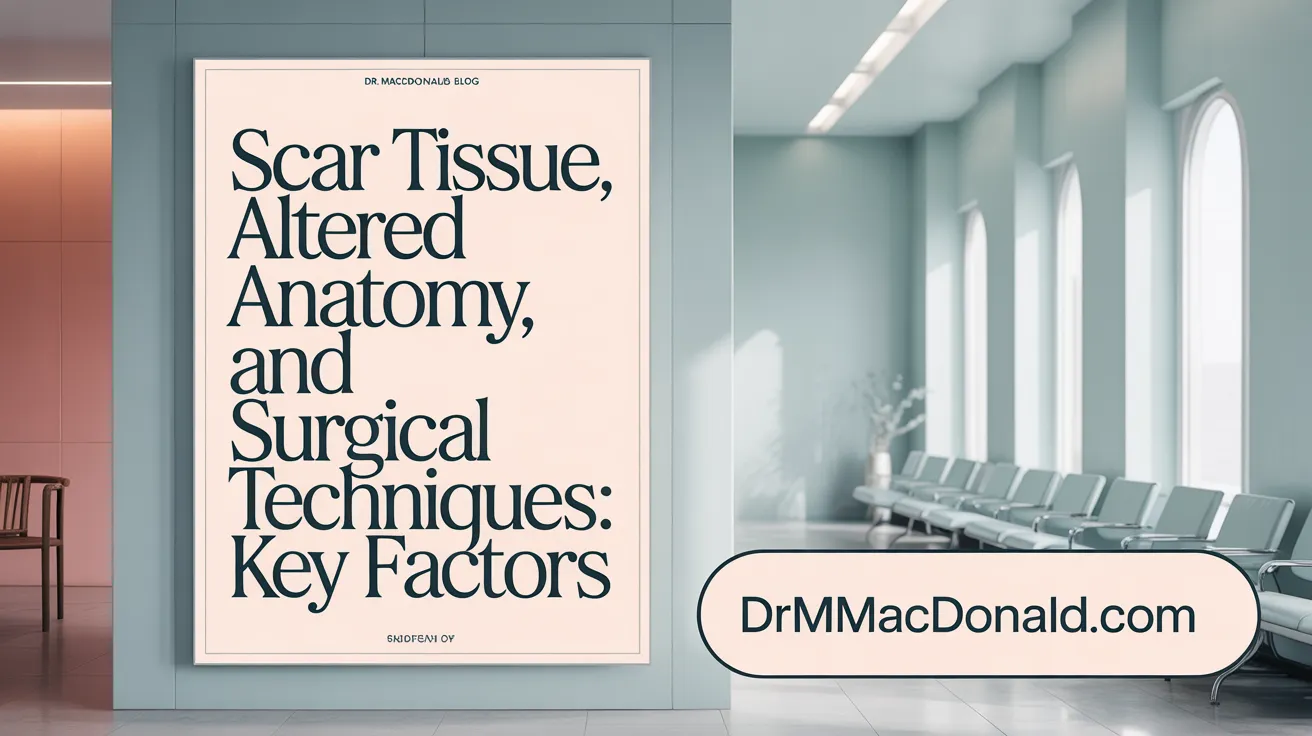Understanding the Need for Revision Rhinoplasty
Definition of Revision Rhinoplasty
Revision rhinoplasty refers to a secondary surgical procedure aimed at correcting or improving the outcomes of a previous nose surgery. Unlike primary rhinoplasty, which builds or reshapes a nose for the first time, revision rhinoplasty addresses unresolved issues or complications from the initial operation. This procedure often involves more complex anatomical challenges due to changes from the first surgery.
Reasons Patients Seek Revision Rhinoplasty
Patients commonly seek revision rhinoplasty for a range of reasons, including dissatisfaction with aesthetic results such as irregular shape or asymmetry, persistent or new functional problems like nasal obstruction or breathing difficulties, and structural deformities caused by prior surgery or injury. Scar tissue formation and changing nasal anatomy over time may also necessitate revision.
Differences Between Primary and Revision Rhinoplasty
Revision rhinoplasty is more intricate than the initial surgery due to factors like scar tissue management, altered nasal anatomy, and limited available cartilage. It often involves advanced techniques such as cartilage grafting from the ear or rib and requires a thorough preoperative evaluation. Recovery can be longer and more involved, with swelling potentially lasting up to a year or more for the final result.
Importance of Specialized Expertise
Due to its complexity, revision rhinoplasty demands a highly skilled and experienced facial plastic surgeon with specialized expertise. Selecting a board-certified surgeon familiar with revision techniques improves the chances of achieving a natural appearance and restoring nasal function. Comprehensive preoperative planning and realistic expectations are essential components for success in revision rhinoplasty.
What Makes Revision Rhinoplasty More Complex Than the Initial Procedure?

Surgical Challenges Unique to Revision Rhinoplasty
Revision rhinoplasty presents distinct challenges compared to initial nose surgery. The complexity arises largely due to changes in the nasal anatomy after the first operation. Surgeons must carefully address structural irregularities and work within an altered landscape, which makes the procedure technically demanding. For more on the complexity, see Challenges of Revision Rhinoplasty.
Scar Tissue and Altered Anatomy Impact
One of the main difficulties in revision rhinoplasty is managing scar tissue from previous surgery. Scar tissue can obscure normal anatomical landmarks and restrict the surgeon's ability to reshape the nose effectively. It also increases the risk of unpredictable healing responses, making precise corrections more difficult to achieve. Learn about the impact of scar tissue in revision surgery.
Open Approach and Surgical Techniques Used
Due to the intricate requirements of revision surgery, an open rhinoplasty surgical approach is commonly employed. This technique involves making incisions that allow full access to the internal nasal framework of bone and cartilage. It enhances visibility and maneuverability, enabling the surgeon to repair deformities or structural damage comprehensively. See details on the open rhinoplasty surgical approach.
Use of Cartilage Grafts from Ear, Rib, or Septum
In many revision cases, the surgeon needs to reconstruct or reinforce nasal structures. This often requires cartilage grafts harvested from the patient's ear, rib, or nasal septum. These grafts restore support and correct deformities caused by excessive removal or damage during the initial rhinoplasty. Utilizing such grafts is essential to balance both the aesthetic appearance and functional integrity of the nose. For more information, see Cartilage Grafting in Revision Rhinoplasty.
This combination of altered anatomy, scar tissue management, advanced surgical access, and the need for grafting makes revision rhinoplasty a specialized and complex procedure that demands experienced surgeons for optimal outcomes. Explore comprehensive insights on Revision Rhinoplasty Overview and Challenges.
Types of Revision Rhinoplasty and Procedure Options

Full Revision Rhinoplasty versus Touch-Up Rhinoplasty
Revision rhinoplasty can range from comprehensive corrections to minor touch-up rhinoplasty. Full revision rhinoplasty involves a complete restructuring and repair of nasal bones and cartilage, usually required when significant deformities or functional issues persist following the initial surgery. This approach often necessitates an open rhinoplasty surgical approach to provide broad access to nasal structures.
Touch-up rhinoplasty is less extensive, focusing on correcting minor imperfections such as subtle bumps, uneven edges, or slight asymmetries that have become apparent after the primary procedure. It is often a minimally invasive procedure involving limited bone or cartilage reshaping.
Non-Surgical Options like Dermal Fillers
For patients seeking minor cosmetic corrections without surgery, non-surgical revision rhinoplasty using dermal fillers offers an alternative. This outpatient procedure involves injecting fillers such as Juvederm or Restylane to smooth out small irregularities and improve nasal contour temporarily. Benefits include no downtime, immediate results, and no incisions or scarring. However, it does not address structural or functional nasal issues.
When Cartilage Grafting or Open Surgery is Necessary
More complex revision cases often require cartilage grafting in rhinoplasty to restore nasal support and shape. Cartilage is harvested from the nasal septum, ear, or rib when previous surgery has caused over-resection or structural collapse. Open rhinoplasty surgical approach is generally necessary for these cases, providing surgeons with complete access to recontour the nose and properly place grafts while managing scar tissue and restoring function.
Procedural Setting and Anesthesia
Revision rhinoplasty is typically performed under general anesthesia for nose surgery in an accredited surgical facility to ensure patient safety and comfort. The complexity of the surgery and use of the open approach necessitate a controlled environment and specialized surgical teams. For less invasive procedures like touch-ups or non-surgical filler treatments, local anesthesia or topical numbing agents are commonly used.
Patient Considerations: Timing, Expectations, and Choosing the Right Surgeon

How Long Should You Wait Before Revision Rhinoplasty?
Experts recommend waiting at least 10 to 12 months after your initial rhinoplasty before undergoing revision rhinoplasty surgery. This allows swelling to fully subside and the nose to settle into its final shape, providing a clear understanding of what corrections are truly needed. This waiting period is crucial to avoid premature surgery and to set the stage for better surgical outcomes. For more on the revision rhinoplasty recovery timeline, see additional resources.
Why Are Realistic Expectations Important?
Revision rhinoplasty is inherently more complex than a primary procedure, involving challenges like scar tissue and altered nasal anatomy. Patients must understand that while skilled surgeons strive for optimal results, perfection cannot be guaranteed. Having reasonable expectations about the achievable improvements helps patients maintain satisfaction and cope with the healing process, which can often take a year or more. Learn about scar tissue impact on revision surgery.
What Criteria Should You Use to Choose Your Surgeon?
Selecting an experienced, board-certified facial plastic surgeon specialized in revision rhinoplasty is essential. Look for surgeons who have extensive revision case portfolios, a strong academic background, and good patient reviews. Their expertise dramatically increases the chances of successful outcomes due to the technical complexities involved in managing scar tissue and reconstructing nasal structures. Consider their familiarity with cartilage grafting in revision rhinoplasty.
How Do Computer Imaging and Patient Consultations Help?
Surgeons use computer-assisted imaging tools during preoperative consultations to help patients visualize potential outcomes. This technology facilitates clear communication about achievable results and surgical plans. Additionally, consultations offer the opportunity to review the surgeon’s past results and address any questions or concerns, helping patients make informed decisions about their revision surgery. For further details, see initial consultation for revision rhinoplasty.
The Road to Recovery: What to Expect After Revision Rhinoplasty

Postoperative Care and Recovery Timeline
After revision rhinoplasty, patients should be prepared for a careful and gradual healing process that demands patience and adherence to postoperative care in revision rhinoplasty. Initially, the nose will be protected with a nose splint use after surgery, usually worn for about one week to help maintain the new shape and provide support.
Managing Swelling, Bruising, and Complications
Swelling and bruising are common in the early recovery phase, typically peaking within the first few days and gradually diminishing over several weeks. Applying cold compresses for swelling after rhinoplasty to the eyes, cheeks, and forehead during the first 3 days can help reduce swelling. Patients are advised to sleep with the head elevated after rhinoplasty at a 45-60 degree angle to minimize inflammation.
Bruising generally fades within the first 2 to 3 weeks, but subtle swelling can persist for months. It is essential to avoid strenuous activity, heavy lifting, and any actions that increase blood pressure or heart rate for at least one month post-surgery to prevent complications. Nasal congestion and minor asymmetries are common initially and do not typically indicate problems. See also swelling and bruising management post rhinoplasty.
Use of Nose Splints and Follow-Up Appointments
Wearing a nose splint use after surgery for the first week post-op is critical to safeguard the structural changes. Follow-up appointments with the surgeon are vital for monitoring healing progress, managing any concerns related to scar tissue, and ensuring the nose is healing correctly. Patients should strictly follow medication regimens, including antibiotics and pain management, as prescribed by their surgeon.
Duration for Final Results to Manifest
Unlike primary rhinoplasty, recovery from revision surgery tends to be longer and more involved. While most bruising and significant swelling resolve within 3 weeks, it may take 6 to 12 months, or sometimes even up to 2 years, for the final nasal contours to fully emerge as residual swelling dissipates. See more about the Revision Rhinoplasty Recovery Timeline for details.
Differences in Recovery Compared to Primary Rhinoplasty
Differences in recovery between primary and revision rhinoplasty often involve handling scar tissue and previously altered anatomy, making it a more complex procedure. This complexity translates into longer swelling duration and a more cautious recovery approach. Patients often require more meticulous postoperative care in revision rhinoplasty and a longer timeline before seeing the ultimate aesthetic and functional outcomes than with initial rhinoplasty procedures.
Adhering closely to Rhinoplasty post-operative instructions and maintaining realistic expectations about the recovery timeline is essential for achieving satisfactory results from revision rhinoplasty.
Revision Rhinoplasty: Achieving Improved Aesthetic and Functional Outcomes with Expert Care
Benefits and Complexities of Revision Rhinoplasty
Revision rhinoplasty offers patients the opportunity to correct unsatisfactory results from an initial nose surgery or address functional issues such as breathing difficulties. This procedure can refine the nasal shape, restore structural support, and improve nasal symmetry. However, it is inherently more complex than primary rhinoplasty due to factors like scar tissue, altered anatomy, and the delicate balance between aesthetic goals and nasal function. Cartilage grafting, often from the ear or rib, may be necessary to reconstruct and support the nasal framework.
The Role of Specialized Surgeons and Patient Commitment
Given its complexity, revision rhinoplasty demands surgeons with specialized training and extensive experience in nasal surgery. Board-certified surgeons who have performed numerous revisions are best equipped to navigate the challenges and achieve favorable outcomes. Patient commitment to preoperative and postoperative care—including waiting an appropriate time after the initial surgery, following recovery protocols, and managing expectations—is essential for successful healing and optimal results.
Encouragement for Prospective Patients
If you are considering revision rhinoplasty due to dissatisfaction or functional difficulties, consulting with an experienced facial plastic surgeon is crucial. Personalized evaluation and advanced planning, including imaging techniques, can help set realistic goals. With expert care and patient dedication, revision rhinoplasty can restore both the appearance and function of the nose, enhancing confidence and quality of life.
